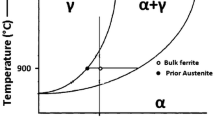Conclusions
The presence of oxides in silicon nitride leads to the formation of an intergranular vitreous phase which has an adverse effect on the high-temperature physicomechanical characteristics of constructional silicon nitride ceramics. This phenomenon is particularly pronounced with silicon nitride contaminated with calcium, silicon, and alkaline metal oxides. Future development work on oxidation-resistant constructional materials based on silicon nitride should go in the directions of removal of impurities and use of additions forming solid solutions or refractory compounds with Si3N4 and SiO2. Additions which can be employed for this purpose include oxides of AI, Mg, Y, and some rare-earth elements.
Similar content being viewed by others
Literature cited
L. J. Godfrey (editor), Proceedings of the British Ceramic Society, No. 22 (1973).
K. H. Jack, “Sialons and related nitrogen ceramics,” J. Mater. Sci.,11, No. 6, 1135–1158 (1976).
I. S. Huseby and G. Petzow, “Influences of various densifying additives on hot-pressed Si3N4”, Powder Metall. Int.,6, No. 1, 17–19 (1974).
W. D. Kingery, Introduction to Ceramics [Russian translation], Stroiizdat, Moscow (1970).
D. W. Richerson, “Effect of impurities on the high-temperature properties of hot pressed Si3N4,” Am. Ceram. Soc. Bull.,52, No. 7, 560–562 and 569 (1973).
J. L. Iskoe, F. F. Lange, et al., “Effect of selected impurities on the high temperature mechanical properties of hot-pressed silicon nitride,” J. Mater. Sci.,11, No. 5, 908–912 (1976).
F. F. Lange, Strong High-Temperature Ceramics, Westinghouse Research Laboratories, Pittsburgh, Rept. No. AD-775218, Feb., 1974.
G. E. Gazza, “Effect of yttria additions on hot-pressed Si3N4,” Am. Ceram. Soc. Bull.,54, No. 9, 778–781 (1975).
Mitomo Mamoru, Oshime Chukei, et al., “Effect of sintering in a nitrogen atmosphere on the microstructure of Si3N4,” Yogyo Kyokaishi, J. Ceram. Soc. Jpn.,84, No. 972, 356–360 (1976).
J. S. Thorp and R. I. Sharif, “Electrical conductivity in hot-pressed nitrogen ceramics,” J. Mater. Sci.,11, No. 8, 1494–1500 (1976).
K. H. Jack and W.I. Wilson, “Ceramics based on the Si-Al-O-N and related systems,” Nature Phys. Sci,238, No. 7, 28–29 (1972).
Oyama Yoichi and Kamigaito Osami, “Sinterability in the Si3N4-MgO system,” Yogyo Kyokaishi, J. Ceram. Soc. Jpn.,81, No. 935, 290–293 (1973).
Tsuge Akihiko, K. Nishia, and M. Komatsu, “Effect of a crystallizing grain-boundary glass phase on the high-temperature strength of hot-pressed Si3N4 containing Y2O3” J. Am. Ceram. Soc.,58, Nos. 7–8, 323–326 (1975).
Kamiya Nobuo, Oyama Yoichi, et al., “Silicon nitride solid solution in the ternary system Si3N4-AlN-SiO2,” Yogyo Kyokaishi, J. Ceram. Soc. Jpn.,83, No. 963, 553–557 (1975).
Author information
Authors and Affiliations
Additional information
Translated from Poroshkovaya Metallurgiya, No. 1(193), pp. 75–80, January, 1979.
Rights and permissions
About this article
Cite this article
Podobeda, L.G. Effect of impurities on the properties of silicon nitride materials. Powder Metall Met Ceram 18, 59–63 (1979). https://doi.org/10.1007/BF00791895
Received:
Issue Date:
DOI: https://doi.org/10.1007/BF00791895




